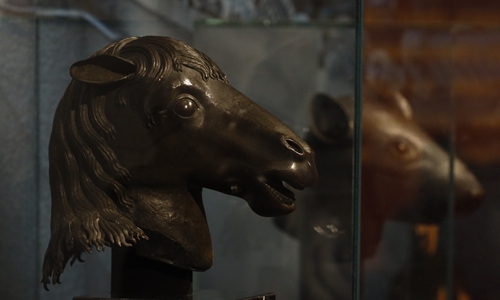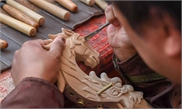
A picture of the horse head. Photo: Li Hao/GT
The return of a bronze horse zodiac head to its home at Yuanmingyuan (the Old Summer Palace) on Tuesday was a crucial step in the homecoming of important cultural relics stolen by invaders over 100 years ago, and evoked the sentiment among Chinese netizens as many view the return as a symbol of "washing off national humiliation."
On Tuesday, the bronze horse zodiac head, which was stolen by British and French troops 160 years ago, finally returned to its original home, the Old Summer Palace, becoming the first significant overseas cultural relic to return to the palace.
Liu Yuzhu, head of the National Cultural Heritage Administration, said at the return ceremony that the statue carries China's historical memories and national sentiment, and its return interprets the profound truth that "cultural relics get lost if the nation is weak, and the culture is prosperous if the nation is strong."
The return evoked the patriotism of Chinese netizens who cheered on Chinese social media by posting "welcome home." The hashtag of "bronze horse head returning to Yuanmingyuan" quickly trended on Sina Weibo, with 250 million views as of Tuesday afternoon.
"Chinese people should not forget the centuries of humiliation, and the Western powers are still eyeing us...We must work harder to make our nation stronger," one Chinese netizen wrote and gained a lot of thumbs-up responses on Weibo.
This year is the 160th anniversary of the massive looting and destruction of the Old Summer Palace.
Liu noted that the success of the horse head's turbulent return is highly related to the efforts of the government and compatriots from Hong Kong and Macao.
On November 13, 2019 the late Macao casino tycoon Stanley Ho donated the statue to the National Museum of China's collection to celebrate the 70th anniversary of the founding of the People's Republic of China. He bought it for HK$69.1 million ($8.84 million) at an auction in September 2007.
Pansy Ho, his daughter, expressed her feelings on Tuesday via a recorded video played at the ceremony, saying that the return of the bronze horse head shows the Hong Kong and Macao compatriots' love to the motherland and the hope that more people could enjoy the beauty of Chinese culture through the exhibition.
Many Chinese netizens also called for more returns of Chinese cultural relics lost overseas.
Li Xiangyang, deputy director of the Old Summer Palace's management office, told the Global Times that the lost relics from the Old Summer Palace are mainly kept in the UK and France, due to the Second Opium War (1856-60).
Liu Yang, an expert from the association of the Old Summer Place, told the Global Times that the exact size of the Old Summer Palace's cultural collection remains unknown, since its archives were lost. However, according to the construction ratio of the Forbidden City, about 800,000 to 1 million cultural relics were lost, and the palace currently only has about a few national leveled cultural relics and about 2,000 stone inscriptions and bricks.
Huo Zhengxin, a law professor at the China University of Political Science and Law, told the Global Times that lost overseas cultural relics are returned to China in four ways - through legal channels, by holding diplomatic negotiations, by purchasing them and by donating them.


